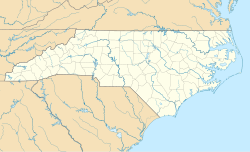Gastonia | |
|---|---|
 Downtown Gastonia | |
| Nickname: Spindle City | |
| Motto: "Great Place. Great People. Great Promise." | |
| Coordinates: 35°14′57″N81°11′08″W / 35.24917°N 81.18556°W | |
| Country | United States |
| State | North Carolina |
| County | Gaston |
| Incorporated | 1877 |
| Named after | William Gaston |
| Government | |
| • Type | Council–manager [1] |
| • Mayor | Richard Franks (R) [2] |
| Area | |
• Total | 52.22 sq mi (135.24 km2) |
| • Land | 51.99 sq mi (134.65 km2) |
| • Water | 0.23 sq mi (0.59 km2) 0.44% |
| Elevation | 738 ft (225 m) |
| Population (2020) | |
• Total | 80,411 |
• Estimate (2023) | 83,942 |
| • Density | 1,546.7/sq mi (597.17/km2) |
| • Urban | 176,897 (US: 208th) [5] |
| • Urban density | 1,420/sq mi (548.2/km2) |
| Time zone | UTC−5 (EST) |
| • Summer (DST) | UTC−4 (EDT) |
| ZIP Codes | 28052–28056 |
| Area codes | 704, 980 |
| FIPS code | 37-25580 [6] |
| GNIS feature ID | 2403684 [4] |
| Website | www |
Gastonia is the county seat of Gaston County, North Carolina, United States. The most populous city in the county and the 13th-most populous city in North Carolina, the population was 80,411 at the 2020 census. [7] [8] It is part of the Charlotte-Concord-Gastonia, NC-SC Metropolitan Statistical Area, which is part of the Charlotte-Concord, NC-SC Combined Statistical Area. [9]
Contents
- History
- National Register of Historic Places
- Geography
- Climate
- Demographics
- Population
- Crime
- Economy
- Arts and culture
- Retail
- Sports
- Government
- Law enforcement
- Fire and rescue
- Education
- K–12
- College and university
- Library
- Media
- Newspaper
- Radio
- Infrastructure
- Transportation
- Notable people
- Sister cities
- See also
- References
- External links
The city is a historic center for textile manufacturing and was the site of the Loray Mill Strike of 1929, which became a key event in the labor movement. While manufacturing remains important to the local economy, the city also has healthcare, education, and government sectors.












